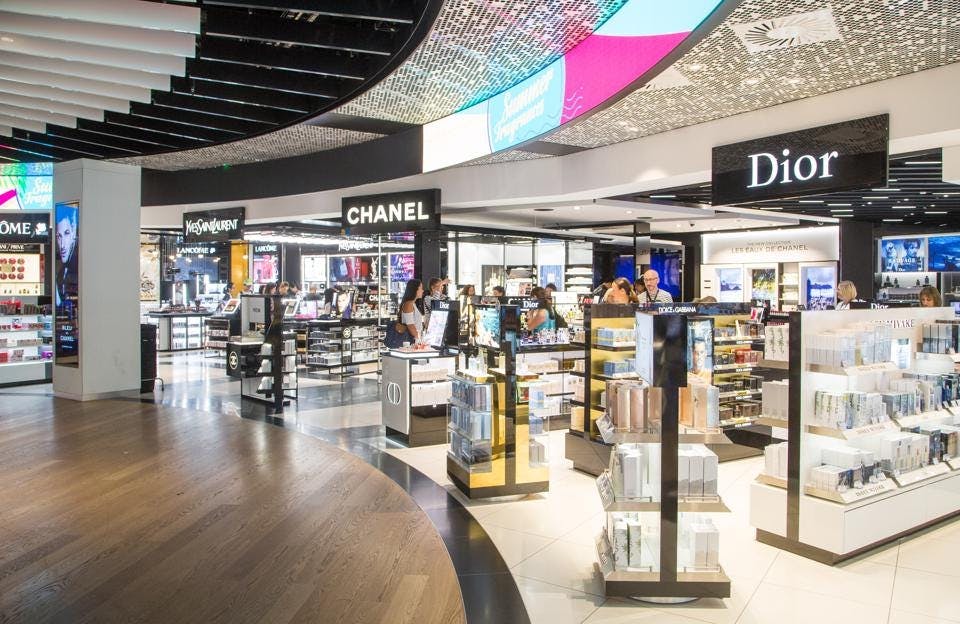For the owners of Gatwick Airport, the U.K.’s second biggest airport, April 2022 was a significant moment: for the first time since the emergence of the COVID-19 pandemic, the Express train route from central London to the terminal reopened. It’s a sign, Gatwick hopes, that some normalcy is returning to the travel sector. Still, that word “some” is doing a great deal of heavy lifting, airport bosses concede—they fear their industry will never be the same again.
For the retailers that inhabit the world’s airports—and particularly the luxury marques selling more expensive goods—such concerns raise some difficult questions. Will they again ever be able to rely on passengers passing through airports buying goods in segments such as fashion, beauty, consumer electronics, and food and drink?
Prior to COVID-19, airports represented a rare bright spot in the battle between physical retail and e-commerce; passengers passing through airports may have deserted high street stores, but they were still spending large sums when on their travels. The pandemic saw airports close and passenger numbers plummet as travel restrictions limited demand for flights, but retailers had hoped to see a resurgence as the world reopened.

Air travel is bouncing back
The good news is that air travel is resuming. The International Air Transport Association says overall traveller numbers were at 47% of their 2019 levels in 2021, but expects this to increase to 83% in 2022—and to exceed pre-pandemic numbers by 2024.
In the U.S., airlines saw a significant return of passengers last year. European airports which reported an increase in passengers in 2021 compared with 2020 included Frankfurt, Amsterdam Schiphol, and Paris Charles de Gaulle, though London’s Heathrow saw a slower recovery. The catch-up in Asia is taking longer, but does appear to be underway.
However, more passengers does not necessarily equate to a happier outlook for retailers plying their trade in airports around the world. Analysts see a problem: it appears that the passengers planning to fly in the next few years are not the ones who used to take to the air; and many of them look less likely to be big spenders in airport retail outlets.
The declining demand for luxury goods
A new report from the consultant Bain & Company makes particularly depressing reading for these retailers. It forecasts a significant increase in the proportion of younger and less affluent travelers. By 2025, Bain reckons, this group will account for more than 50% of all passengers, while the share of business travel, long-haul groups, and Chinese passengers—all of whom are the traditional consumers of the luxury goods sold at airports—will have declined sharply.
Another problem, according to Bain, is that digital retail now poses more of a threat to bricks and mortar outlets in the airport. It thinks the percentage of airport retail sales that are directly influenced by online sites will rise to 30%, up from low single digits today.
The result for traditional airport retailers is that the recovery in their revenues is unlikely to run parallel to those higher passenger numbers. Airport footfall may increase, but travellers won’t get their wallets out. Bain thinks that even by 2025, passenger spending in airports will be at less than 80% of the levels seen in 2019, before the pandemic, even if ecommerce sales provide some additional revenues.
Against this backdrop, many airport stores, particularly at the luxury end of the market, have yet to reopen and may never do so. They point out that the changing mix of airport passengers no longer justifies the cost of leasing space from operators; their money is better invested elsewhere.
Identifying new opportunities
Naturally, the picture is mixed. In some areas of the world, airport retail is doing much better. China’s introduction of lower duties on sales in the domestic market, for example, has seen airport spending increase sharply. In the U.K., the government hopes to boost its airport industry with a post-Brexit tax regime that encourages passengers to spend.
Nor are the differences only geographical. The shift towards younger, non-business travelers in many airports creates opportunities for different types of retail tenants, particularly in the fashion sector. Many food and drink retailers, meanwhile, are less concerned about passenger demographics.
Digital is the other big theme that many airport retailers are now exploring. For example, SEA Milan Airports and JFKIAT, which operates Terminal 4 at JFK Airport in New York, have introduced online portals for their luxury retailers. These digital storefronts give passengers more time to browse from home or from the airport lounge before they collect purchases on the day of departure.
Nevertheless, airport retail now looks to be irrevocably changed. The return to the status quo that retailers might have hoped for in the early days of the COVID-19 pandemic simply isn’t going to happen. They will need to adjust their strategies accordingly.

